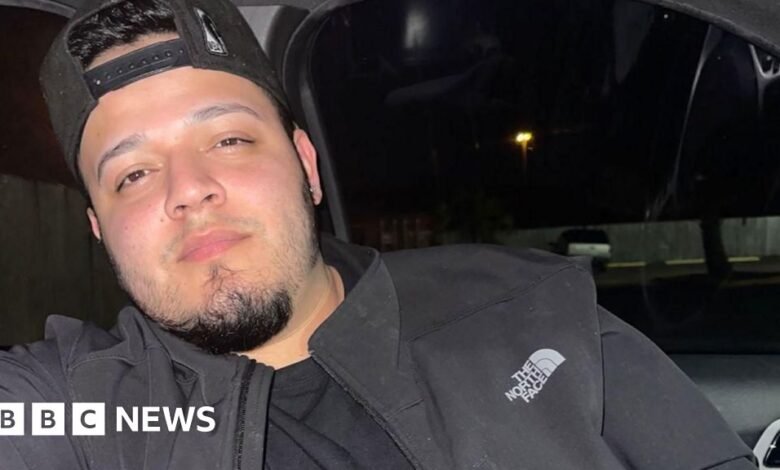Can the US return Kilmar Abrego Garcia from El Salvador?

 Jennifer Vasquez
Jennifer VasquezOn 12 March, Kilmar Abrego Garcia was driving home with his young son in Maryland when he was stopped by agents from US Immigration and Customs Enforcement (ICE).
Agents took Mr Garcia into custody, then shuttled him to detention facilities in Louisiana and Texas.
According to a federal judge, after three days, “without any notice, legal process, or hearing”, Mr Garcia found himself back in his native El Salvador at an infamous prison known for housing gang members.
The government said he was deported due to an “administrative error”.
But despite that, Mr Garcia remains incarcerated in El Salvador as lawyers debate the unusual intricacies of the case.
A Maryland court ordered Mr Garcia be returned to the US, but Trump officials argued that they cannot compel El Salvador to return Mr Garcia. The administration also argued that the judge ordering his return lacked the authority to do so.
On Monday, the Supreme Court put a temporary hold on lower court orders while they consider the matter.
Immigration experts say that as US President Donald Trump takes a hardline approach on illegal immigration, this case has the potential to upend due process for immigrants.
“If the US Supreme Court were to accept [the Trump administration’s] position, it would completely eviscerate any rule of law in the immigration process,” Maureen Sweeney, director of the University of Maryland’s Chacón Center for Immigrant Justice, told the BBC.
“Because they could pick up anybody, at any time, and send them anywhere with no repercussions whatsoever.”
The Trump administration pushes back
US District Judge Paula Xinis wrote in a filing Sunday that ICE officials did not follow procedures in the Immigration and Nationality Act when they deported Mr Garcia to El Salvador.
She ruled the US must bring him back before midnight on Monday. The Fourth Circuit Court of Appeals agreed, writing that the US “has no legal authority to snatch a person who is lawfully present in the United States off the street”.
Yet the Trump administration has argued that it cannot comply, saying Judge Xinis’ filing is outside her jurisdiction.
“Neither a federal district court nor the United States has authority to tell the Government of El Salvador what to do,” US Solicitor General D John Sauer wrote in an appeal to the Supreme Court.
Nicole Hallett, a professor at the University of Chicago Law School said that while it is true – US district judges cannot order El Salvador to take action – they can order the US government to have Mr Garcia returned.
She also said the US has previously facilitated the return of mistakenly deported individuals.
Prof Hallett also questioned the government’s claim that the US is powerless to compel El Salvador to release Mr Garcia, citing an agreement between the two countries.
The US, under the Trump administration, paid El Salvador’s government $6m to house prisoners it sends, according to CBS News, the BBC’s US partner. Top officials like Secretary of State Marco Rubio and Trump himself have publicly touted the arrangement.
“It’s almost as if the Salvadoran government is acting as an agent of the US government,” Ms Hallett said, arguing that this makes the release more plausible.
Mr Garcia’s lawyers argued that because El Salvador was detaining Mr Garcia “at the direct request and pursuant to financial compensation” from the US, the court could order the US government to request his return.
Mr Garcia is among 238 Venezuelans and 23 Salvadorans deported under the Trump administration to El Salvador’s notorious mega-prison. Officials allege they are gang members and therefore are subject to deportation.
Mr Garcia, who is married to a US citizen, does not have any gang ties and has never been charged with a crime, his lawyer says.
He was also protected by a “withholding of removal” order, which means the US government cannot send him back to El Salvador because he could face harm. The order dates back to 2019, when ICE first took Mr Garcia into custody and alleged he belonged to the MS-13 criminal organisation, an allegation he denied at the time.
Such orders are common, immigration lawyers told the BBC, and are an alternative to asylum protections.
“It was an unlawful act, for the US to return him to the country where he could not be returned,” said Amelia Wilson, director of the Immigration Justice Clinic at Pace University.
A judge ultimately granted Mr Garcia the 2019 order after he “testified about how he was a victim of gang violence in El Salvador when he was a teenager and he came to the US to escape all of that,” his wife, Jennifer Vasquez Sura, wrote in a March 2025 affidavit.
Department of Justice attorney Erez Reuveni acknowledged that at the time the “government did not appeal that decision, so it is final”.
The Trump administration now reiterates allegations that Mr Garcia belonged to MS-13, but Judge Xinis said the government made this claim “without any evidence” and had not produced a removal order or warrant.
Supreme Court showdown looms
The Trump administration continues to press its case to the nation’s highest court, setting up a potential showdown over the White House’s deportation strategy.
Chief Justice John Roberts issued an administrative stay on Monday night, pausing lower court rulings while the US Supreme Court considers the government’s appeal.
President Trump touted the stay as a victory, writing on Truth Social that the ruling allowed the president “to secure our Borders, and protect our families and our Country, itself.”
Immigration lawyers, meanwhile, are watching Mr Garcia’s case closely, considering it a test for how much power the administration can exert over US immigration.
“If the Trump administration is trying to remove these individuals by bypassing the immigration courts,” said Ms Wilson, “there’s a direct and obvious line between what they’re doing, and an effort by the administration to completely usurp judicial and due process.”
Source link



